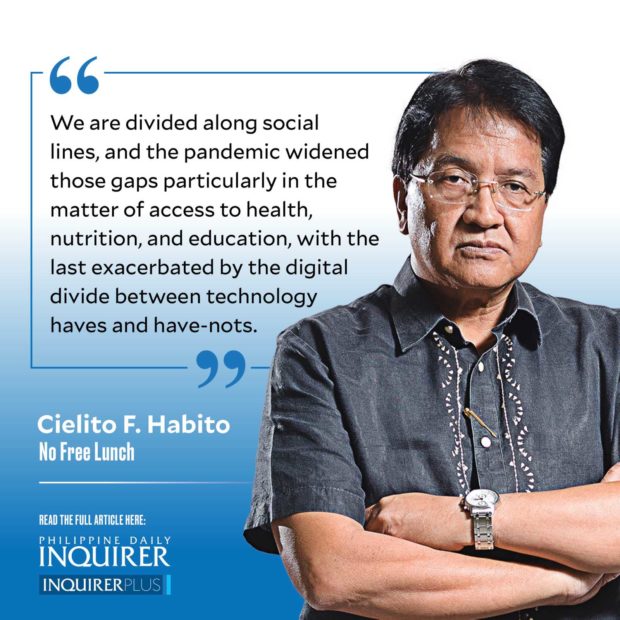In a country as badly divided as ours, it’s refreshing to witness young people taking a direct hand to bridge the gaps that continue to get in our way of building a cohesive nation. Filipinos are divided along various conflict lines, starting with the physical division that comes with being an archipelago of 7,641 islands (as of last official count). With this come cultural divides arising from a diverse ethnic heritage from our storied past. Prominent is the religious divide, especially between the Christian majority and the Muslim minority, but Christians among themselves see marked divisions between the dominant Catholics and various Christian groups, some homegrown, and some of dubious nature.
Our political divides are most prominent at this time, with the electoral campaign for the coming May national elections in full swing. We are also divided along social lines, and the pandemic widened those gaps particularly in the matter of access to health, nutrition, and education, with the last exacerbated by the digital divide between technology haves and have-nots. Economic divides likewise widened as certain industries actually thrived during the pandemic while most others slumped and saw massive job losses, especially in the hard-hit sectors of tourism, entertainment, and personal services.
Against this backdrop, I again found it uplifting and inspiring to listen to the latest cohort of fellows of the Future Bridging Leadership Program (FBLP) of the Asian Institute of Management’s (AIM) TeaM Energy Center for Bridging Leadership. They recently pitched their change initiatives, their “thesis” to culminate a yearlong program that involved workshops, community immersions, constant stakeholder engagement, and countless sessions with AIM faculty, fellows, coaches, and partners. The program aims to help create a successor generation of future leaders, who will be catalysts for social change by bridging divides in society and improving lives as they do. Their projects fall under the categories of capacity building and empowerment; education; health, wellness, and environment; and social enterprise.
Ezel Lambatan seeks to bridge young people in Cagayan de Oro back to agriculture, an occupation feared to lack a successor generation who will sustain this vital economic sector that feeds our population. His “Bayanihan sa Agrikultura para sa Kabatan-onan, Kaumahan ug Katubigan (BAKA)” uses the 4H-club (head, hands, heart, and health) approach to capacitate the youth on agri-fisheries technologies, business planning, and servant leadership. Maria Korina Bertulfo’s “Alalay kay Nanay” project provides training and internship opportunities to young stay-at-home mothers toward online, home-based jobs as a viable means of livelihood. With this, she hopes to “change the world, one mom at a time.” Queenie Pearl Tomaro’s “YouthTeach” engages youth in Valencia City, Bukidnon, to help reading-impaired Grade 5 and 6 pupils with an arts-based reading program that makes it engaging and motivating. Saje Miguel Molato seeks to strengthen a Community Learning Hub in Tabaco City, Albay, with improved educational materials, learning tools, devices, and equipment, and engage young volunteer tutors in the effort.
To address the needs of conflict-affected communities in Patikul, Sulu, Fatimatuzzahra Abdulmajid, a licensed psychometrician, is pursuing her project EARSHED, a takeoff from the Arabic word Ershad, meaning “universal guidance.” It aims to provide psychosocial healing, capacity building, and safe spaces for her target communities. Medical student Samuel Madriaga is spearheading Healthy Kabataan 2025 in San Pablo City, where he is actively working with the city government as a leading youth health champion. John Marlou Salido’s “Kilos! Ikaw, Tayo’y Aangat (KITA) Initiative” seeks to level up the indigent micro-entrepreneurs in his target communities with access to e-commerce and other digital technologies to empower their businesses.
These are but a peek into what the new FBLP fellows are up to. Their tribe of bridging leaders is growing, and we need many more to achieve a Philippines that can genuinely claim to be one as a nation.
